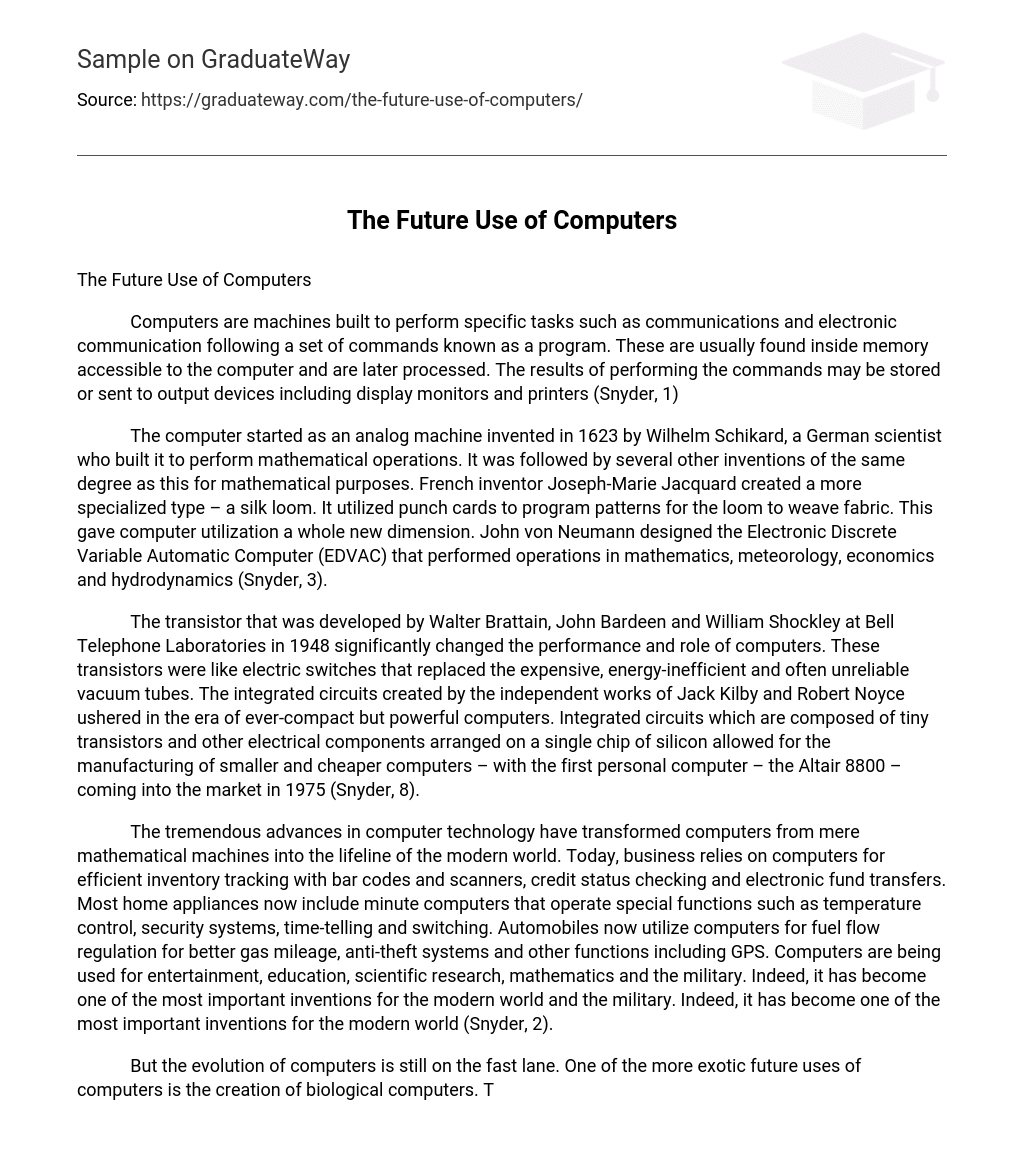Computers are machines built to perform specific tasks such as communications and electronic communication following a set of commands known as a program. These are usually found inside memory accessible to the computer and are later processed. The results of performing the commands may be stored or sent to output devices including display monitors and printers (Snyder, 1)
The computer started as an analog machine invented in 1623 by Wilhelm Schikard, a German scientist who built it to perform mathematical operations. It was followed by several other inventions of the same degree as this for mathematical purposes. French inventor Joseph-Marie Jacquard created a more specialized type – a silk loom. It utilized punch cards to program patterns for the loom to weave fabric. This gave computer utilization a whole new dimension. John von Neumann designed the Electronic Discrete Variable Automatic Computer (EDVAC) that performed operations in mathematics, meteorology, economics and hydrodynamics (Snyder, 3).
The transistor that was developed by Walter Brattain, John Bardeen and William Shockley at Bell Telephone Laboratories in 1948 significantly changed the performance and role of computers. These transistors were like electric switches that replaced the expensive, energy-inefficient and often unreliable vacuum tubes. The integrated circuits created by the independent works of Jack Kilby and Robert Noyce ushered in the era of ever-compact but powerful computers. Integrated circuits which are composed of tiny transistors and other electrical components arranged on a single chip of silicon allowed for the manufacturing of smaller and cheaper computers – with the first personal computer – the Altair 8800 – coming into the market in 1975 (Snyder, 8).
The tremendous advances in computer technology have transformed computers from mere mathematical machines into the lifeline of the modern world. Today, business relies on computers for efficient inventory tracking with bar codes and scanners, credit status checking and electronic fund transfers. Most home appliances now include minute computers that operate special functions such as temperature control, security systems, time-telling and switching. Automobiles now utilize computers for fuel flow regulation for better gas mileage, anti-theft systems and other functions including GPS. Computers are being used for entertainment, education, scientific research, mathematics and the military. Indeed, it has become one of the most important inventions for the modern world and the military. Indeed, it has become one of the most important inventions for the modern world (Snyder, 2).
But the evolution of computers is still on the fast lane. One of the more exotic future uses of computers is the creation of biological computers. The first of these futuristic computers was created in 1999 by scientists led by Professor Bill Ditto at the Georgia Institute of Technology. This computer had neurons from leeches as its components and can perform basic sum operations. It has been called the “leech-ulator”. The neurons are placed in a petri dish with micro-electrodes inserted in each of them. The neurons have unique electrical activities and responses to electrical stimuli. Because of these characteristics, each neuron can be made to represent a number and calculations can be made by connecting these individual neurons. The potential of biological computers lies in the idea of creating a new generation of faster and more flexible computers that can solve problems without the need for strict and precise programming. Computers today still require correct information and programming to get an answer. The biological computer has the potential to come up with answers with even partial information by filling up the gaps by itself. The “leech-ulator” can “think for itself” because the neurons can form connections by themselves unlike normal silicon processors that can establish connections only under the specific instructions of the programmer. The team that invented the “leech-ulator” envisions it being used later for pattern recognition operations such as reading handwriting that could take up too much power to be done well on electronic and mechanical computers. Because the device works similar, although simpler, to the human brain, the long term goal is to create a robot brain which would be otherwise impossible for supercomputers because of portability constraints (BBC, 1).
A more recent development is the creation of a computer capable of performing 330 trillion operations per second (100,000 times the current speed of the fastest PC) that runs on deoxyribonucleic acid or DNA. Israeli scientists at the Weizmann Institute of Scieence in Rehovot, Israel, in 2003, were able to invent this programmable molecular computer with enzymes and DNA molecules to replace the traditional silicon chips. The DNA provides not only the input data but also the fuel for running the operations. It has been dubbed by the Guiness World Records as the “smallest biological computing device” yet to be created. Although biochemical “nanocomputers” are already present in nature, they are uncontrolled by humans. This machine incorporated in a test tube DNA as the fuel source and software while utilized the enzymes as the hardware. The operations are controlled via the chemical reactions that control the composition of DNA molecules. Although it can currently perform basic functions, it has great potential for pharmaceutical and biomedical applications (Lovgren, 1).
Indeed, innovation and change never runs out for the computer. Soon, these proposed future uses will become reality and they will bring computers to a whole new level – for the benefit of mankind.
Bibliography
BBC. “Biological computer born.” BBC Online. 2 June 1999. 10 May 2007. http://news.bbc.co.uk/1/hi/sci/tech/358822.stm.
Lovgren, Stefan. “Computer made from DNA and enzymes.” National Geographic News. 24 February 2003. 10 May 2007. http://news.nationalgeographic.com/news/2003/020224_030224_DNAcomputer.html.
Snyder, Timothy Law. “Computer.” Microsoft Encarta 2007 [DVD]. Redmond, WA: Microsoft Corporation, 2006.





